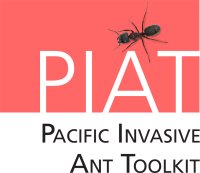Red imported fire ant response case study
|
In 2006 workers at a forest products facility in Whirinaki (approximately 10 km north of Napier, New Zealand) noticed unusual ants and ant mounds in a storage area of the facility. The workers notified the Ministry for Primary Industries (MPI) via the exotic pests and diseases hotline. MPI biosecurity officers identified a single red imported fire ant (RIFA) nest (Solenopsis invicta) of about 30,000 workers covering an area of approximately 2 m2 and the nest was destroyed. |

A group of red imported fire ant workers surround and attack a meal worm (© Phil Lester) |
Surveillance and eradication
Because of the environmental and social risks associated with RIFA and the potential restrictions on exports if they became established, a Technical Advisory Group recommended an intensive three year surveillance and treatment programme within a 2 km radius of the nest find. This time frame was given as ant nests present at the time would grow to a detectable size over this period. Only if no nests were detected during this period could eradication be declared.
The three-year surveillance and eradication programme included the following activities:
- Four rounds of surveillance involving visual surveys and the use of attractive lure pottles. Pottles were deployed at a minimum density of four pots per equivalent 10 m x 10 m grid (100 m2) within a 2 km radius of the nest. Over the three-year programme, more than 900 000 pottle samples were collected.
- For areas not able to be accessed by foot for surveillance, aerial treatments using insecticidal ant baits (either Distance® [pyriproxyfen, 5 g/kg], Engage® [S-methoprene, 5 g/kg] or Maxforce® Pro [hydramethylnon, 10 g/kg]) were applied at a rate of 2 kg/ha. Six rounds of bait were applied to these areas by helicopter over the three year period.
- Regular supplementary monitoring of the area by visual survey out to 200 m from the original nest site.
- Regular passive monitoring using pitfall traps out to 200 m from the original nest find.
- Tracing of all known risk goods in and out of the incursion site from the time the nest was believed to have established.
Movement controls
A controlled area (using the provisions of the Biosecurity Act 1993) was put in place extending out in a 2 km radius of where the nest was found, restricting the movement of all those that lived and worked within this zone, and thus could be potential fire ant conveyors that could cause further spread.
Movement controls were not lifted until 2009 when eradication was declared. Though maintaining a controlled area can cause considerable extra work for businesses and locals living within it, it is essential in order to contain an incursion.
Controlled area procedures included:
- A permitting system for movements of risk goods out of the controlled area, and registering all permit requests, approvals and declined applications
- Public awareness building around treatment protocols
- Procedures for non-compliance with RIFA movement controls
- Maintaining a register of all potential and actual compensation issues
- Management of public enquiries
Public awareness campaign
Public awareness about RIFA and the incursion was raised by communications/liaison activities including the creation of a fact sheet, public meetings and school visits.
Regular advisories were also emailed as well as hand delivered to all businesses/residences in the 2 km movement controlled area. Additionally, updates were provided to the Minister.
Regular media releases and interviews were made. Presentations on the RIFA response were presented and discussed at national and international conferences.
Pathway analysis
An analysis of pathways could not find an introduction pathway for the incursion; the occupier of the site was primarily an exporter, and the majority of imports came from Europe (a RIFA free zone). The origins of the RIFA incursion remain unknown.
Conclusions
Following an intensive three-year surveillance programme, MAF Biosecurity New Zealand (MAFBNZ) declared the successful eradication of RIFA from Whirinaki in 2009. This activity demonstrates the usefulness of a well-publicised exotic pest and disease hotline in promoting rapid response to incursions. The response also illustrates the labour intensive and rigorous procedures necessary before eradication can formally be declared.
Information sources
Information for this case study was kindly provided by Sheree Christian, Tim Ryder and Rebecca Tayler, New Zealand Ministry for Primary Industries, Plants and Environment Response
MFA. 2001. Case study 5: response to the incursion of the red imported fire ant (Auckland)
content reviewed by Souad Boudjelas, Pacific Invasives Initiative, November 2016
